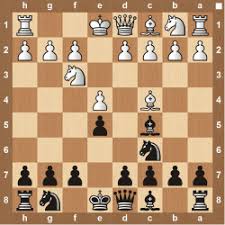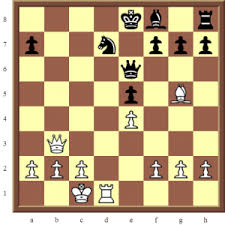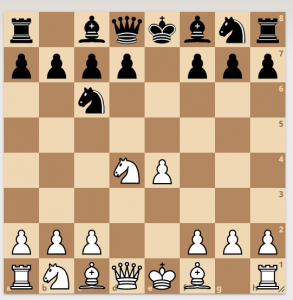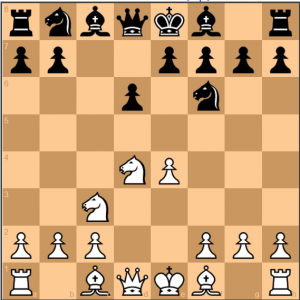
In my previous blog post “Three Ideas for a Race Against Time” , I wrote about how a player should divide a game’s time control by 40, the average number of moves in a chess game, to determine the rough amount of time he should spend per move. However, one needs to know the types of transformational moves that require more analysis. Before making a , sacrifice, trade or pawn move it is important to spend extra time, considering the long-term ramifications. After these moves, the positions will never be the same:
Sacrifices
Despite what many players believe, one can not make a sacrifice based on his intuition. As Jim Egerton writes about in Business on the Board , a player needs if to get a good return on investment in the event that he makes a sacrifice.

In this position from the Gioco Piano, white should most certainly not sacrifice with 4. Bxf7+. On one hand, he will get a little bit of compensation because black will have an exposed king after 4….Kxf7. However, his slight disadvantage in king safety will not be nearly enough of a return to equate the black’s 3 point surplus in material.
To the contrary, let’s take a peak at this example from the well-known Paul Morphy vs the Duke of Brunswick Game that took place in Paris in 1858:

In this position, Former World Champion Paul Morphy played 16. Qb8+. Like many chess educators, I have shown this game to hundreds of students over the years. Most beginners will see Qb8+ as a forcing move but will quickly discount it as we discuss black can play 16..Nxb8. However, Morphy did play 16. Qb8+! as after black is forced to play 16…Nxb8, he had the follow-through of 17. Qb8#. One should only make a sacrifice if he absolutely knows that with best play from both sides, he will get sufficient compensation.
Trades
One of the most common mistakes beginners will make is trading at almost opportunity. One should not exchange pieces just because “it is a fair trade”. Once a pair of equally valued pieces gets removed from the board, the game will never be the same. Let’s take a look at a common example from the Scotch Opening:

In this position, white just played 2. Nxd4…. should black respond with Nxd4, forcing white’s queen to come to the center with Qxd4? He should not as the queen would be active on d4 and there is no good way to take advantage of the queen being out too early. To learn more about when it is worth trading, read this prior blog post.
Pawn Moves
A pawn move may not seem like such a big deal; however, we need to remember that pawns never move backwards! If we move any other piece forward, it can always move back but pawn moves are permanent. As I remind students like a broken record, every pawn move makes a weakness!

In this Sicilian position, one of black’s main options is playing 5..e5, the Sveshnikov Variation. While it is its perks, gaining an initiative by creating a lot of threats, it is a risky as black will have a long-term backward pawn on d6.
Conclusion
While every move should have a purpose and it is important to never let your guard down, there are some critical positions, when you need to spend a lot of time. When you sacrifice, trade or move a pawn, make sure you get a good bang for your buck! Game on.


your means with our online casino’s responsible gaming features and resources.
Enjoy fast payouts and secure transactions every time!
What fabulous ideas you have concerning this subject! By the way, check out my website at <a href="[Link deleted]for content about Cosmetic Treatment.
Every good move creates a potential weakness, so think before you make any decisions.
The site has been a game-changer for me. The app is smooth and user-friendly, offering access to a variety of sports and casino games. The welcome bonus is a great incentive for new users. The mobile platform is convenient, allowing me to place bets on the go. Highly recommend the app for Indian bettors.
Beyond sports, the app also delivers a rich variety of other content, making it a complete package for families and individuals alike. People who enjoy Arabic television dramas or French channels can find exactly what they are looking for inside the app. Movie lovers have the option to stream film channels that broadcast popular Hollywood blockbusters, Bollywood hits, and regional cinema without restrictions.
A trusted partner known for professionalism, expertise, and exceptional attention to detail.구글찌라시 Choosing this service means partnering with a team that values integrity, precision, and client-focused results.
Only aspire to mention ones content can be as incredible. This clarity with your post is superb and that i may think you’re a guru for this issue. High-quality along with your concur permit me to to seize your current give to keep modified by using approaching blog post. Thanks a lot hundreds of along with you should go on the pleasurable get the job done.
Choosing this service means partnering with experts who prioritize your needs and deliver beyond promises.강남쩜오 The reliability and quality of their services have made them an indispensable resource for our ongoing needs.
Some of the best puns ever created are the ones that make people laugh because they are so clever and yet so simple that you can’t help but appreciate the wordplay, and that is why many pun collections include short one-liners that deliver maximum humor in minimum words. For example, jokes like “I’m reading a book on anti-gravity. It’s impossible to put down,” work because they combine science terms with everyday actions in a clever way that surprises the listener.
Planning a meaningful journey, whether it’s a personal goal or a spiritual experience, requires careful guidance and support. For those looking to enrich their spiritual life, <a href="[Link deleted]Travels offers well-organized Umrah and Hajj packages that make the pilgrimage smooth and memorable. Just like navigating life’s challenges, having trusted support can make all the difference in achieving your dreams.
Thanks for sharing these moves. If you are a snapchat user and want to download stories, Snaptroid is the best app.